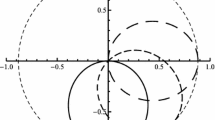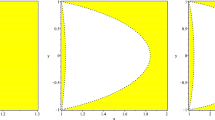Abstract
We examine the singularities of the wave fronts of null geodesics from point sources in the Kerr metric. We find that the wave fronts develop a tube like structure that collapses non-symmetrically, leading to cusp features in the wave front singularities. As the wave front advances, the cusps trace out an astroidal shaped caustic tube, which had been discovered previously using lens mapping and geodesic deviation methods. Thus, the wave front approach in this study helps to complete a picture of caustics and gravitational lensing in the Kerr geometry.

















Similar content being viewed by others
References
Newman, E.T., Penrose, R.: J. Math. Phys. 3, 566–78 (1962)
Everitt, et al.: Phys. Rev. Lett. 106(22), 221101 (2011)
Mizuno, Y., et al.: Nat. Astron. 2, 585–590 (2018)
Ehlers, J., Newman, E.T.: J. Math. Phys. 41, 3344–3378 (2000)
Frittelli, S., Petters, A.O.: Math. Phys. 43, 5578–5611 (2002)
Petters, A.O., Levine, H., Wambsganss, J.: Singularity Theory and Gravitational Lensing. Progress in Mathematical Physics (Book 21). Birkhauser, Basel (2001)
Virbhadra, K.S., Ellis, G.F.R.: Phys. Rev. D 62, 084003 (2000)
Frittelli, S., Kling, T.P., Newman, E.T.: Phys. Rev. D 61, 064021 (2000)
Perlick, V.: Living Rev. Relativity 7, 9. http://www.livingreviews.org/lrr-2004-9 cited on (February 13, 2019)
Bozza, V.: Phys. Rev. D 67, 103006 (2003)
Soreno, M.: Phys. Rev. D 67, 064007 (2003)
Aazami, A., Keeton, C., Petters, A.O.: J. Math. Phys. 52, 092502 (2011)
Porfyriadis, A., Shi, Y., Strominger, A.: Phys. Rev. D 95, 064009 (2017)
Rauch, K., Blandford, R.: Astrophys. J. 421(1), 46–68 (1994)
Sereno, M., De Luca, F.: Phys. Rev. D 78, 023008 (2008)
Bozza, V.: Phys. Rev. D 78, 063014 (2008)
Grould, M., Paumard, T., Perrin, G.: Astron. Astrophys. 591, A116 (2016)
Bozza, V., De Luca, F., Scarpetta, G., Sereno, M.: Phys. Rev. D 72, 083003 (2005)
Frutos-Alfaro, F., Grave, F., Müller, T., Adis, D.: J. Mod. Phys. 3, 1882–1890 (2012)
Hawking, S., Ellis, G.F.R.: The Large Scale Structure of Space–Time. Cambridge University Press, Cambridge (1973)
Cunningham, C.T., Bardeen, J.M.: Astrophys. J. 173, L137–142 (1972)
Chandrasekhar, S.: The Mathematical Theory of Black Holes. Clarendon Press, Oxford (1992)
Carter, B.: Phys. Rev. 174, 1559 (1968)
Press, W., Teukolsky, S., Vetterling, W., Flannery, B.: Numerical Recipes, 3rd edn. Cambridge University Press, Cambridge (2007)
Arnol’d, V.I.: Catastrophe Theory. Springer, Berlin (1992)
Benavides-Gallego, C., Abdujabbarov, A., Bambi, C.: Eur. Phys. J. C. 78, 678 (2018)
Uniyal, R., Nandan, H., Jetzer, P.: Phys. Lett. B 782, 185–192 (2018)
Iyer, S.V.: arXiv:1808.06630 [gr-qc]
Jiang, C., Lin, W.: Phys. Rev. D 97, 024045 (2018)
Jusuti, K., Ougun, A., Saavedra, J., Gonzalez, P., Vasquez, Y.: Phys. Rev. D 97, 124024 (2018)
Cunha, P., Herdeiro, C.: Gen. Relativ. Gravit. 50(4), 42 (2018)
Acknowledgements
E.G. was supported on this work by an Undergraduate Research Summer Grant from the Adrian Tinsley Program at Bridgewater State University. K.R. and H.W. were supported under two separate NASA Space Grants from the Massachusetts Space Consortium.
Author information
Authors and Affiliations
Corresponding author
Additional information
Publisher's Note
Springer Nature remains neutral with regard to jurisdictional claims in published maps and institutional affiliations.
Electronic supplementary material
Below is the link to the electronic supplementary material.
Appendix: Future-directed null geodesics
Appendix: Future-directed null geodesics
Throughout this paper, we have been careful to indicate that the choice of coordinates \((r, \theta , \phi _-, u_-)\) was appropriate for past-directed null geodesics in use with adaptive step-size methods. This is because the null coordinate \(u_-\) is well suited for crossing the event horizon in the past-directed orientation. If one considers the conformal structure of the Kerr solution, as represented in Fig. 17 [20] for example, our light rays are beginning in a standard region I (for sake of argument in a region I on the right). Past directed null geodesics in the \((r, \theta , \phi _-, u_-)\) coordinates smoothly cross the event horizon into the region II (the “white hole”, to the lower left) or approach past null infinity. While one can integrate these coordinates forward in time, they are not well suited for approaching future null infinity or the copy of region II (the “black hole”, to the upper left). In fact, the adaptive step-size code we implement in this paper drives the step-size to zero near the event horizon when using future-directed null geodesics in the \((r, \theta , \phi _-, u_-)\) coordinates.
To compute future-directed null geodesics, it is appropriate to change coordinates to \((r, \theta ,\phi _+,u_+)\) using the coordinate transformation
In these coordinates, one can smoothly integrate using adaptive step-size for future-directed null geodesics, reaching future null infinity or the region II corresponding to the “black hole”. The only difference in the mathematics presented in this paper are that the terms in the metric in front of the \(dr d\phi _-\) and \(dr du_-\) change sign. This corresponds to a change in sign of our functions labeled \(T_2\) and \(T_3\) in the Lagrangian and subsequent Euler–Lagrange equations. It is for this reason that we did not simplify our equations by noting that \(T_3=-\,1\) throughout Sect. 3. In our computer code, we have coded for the option of using either coordinate system, where if we want future-directed rays, we use the \(u_+\) and \(\phi _+\) coordinates, and if we want past-directed light rays, we use the \(u_-\) and \(\phi _-\) coordinates.
Rights and permissions
About this article
Cite this article
Kling, T.P., Grotzke, E., Roebuck, K. et al. Examining the Kerr metric through wave fronts of null geodesics. Gen Relativ Gravit 51, 32 (2019). https://doi.org/10.1007/s10714-019-2518-1
Received:
Accepted:
Published:
DOI: https://doi.org/10.1007/s10714-019-2518-1




